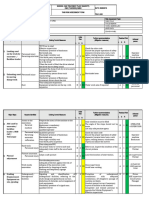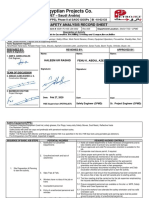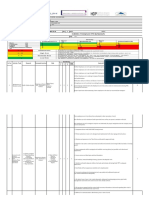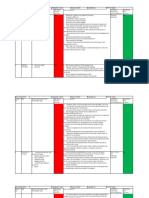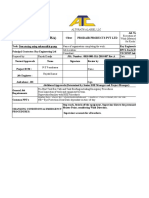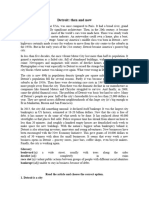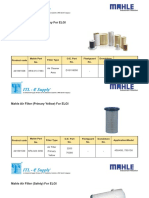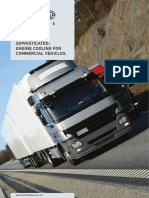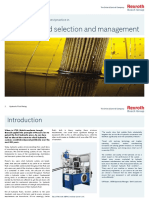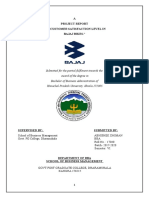Date of assessment Location Approved by:
Work activity: Assessment by:
Severity Likelihood Evaluation of Risk
Minor Injury 1 Very unlikely 1 Action required urgently to control the risk, further resources may be required,
12 - 25 High
Significant 2 Slightly 2 work must stop immediately
Serious 3 Feasible 3 Action required to control the risk, interim measures may be necessary in the
5 – 10 Medium
Major 4 Likely 4 short term, able to proceed with work under supervision
Fatality 5 Very likely 5
1–4 Low This represents a low risk, although control measures must be maintained
Initial Residual
Task Risk Controls
risk/Impact risk
Consequenc
Consequenc
Risk rating
Risk rating
Likelihood
Likelihood
Si Hazard description
Task step/Activity Who might be harm Control measures
No and effect
Excavation collapse Workers 4 4 16 Provision of toolbox talks. 1 3 3
Excavation and Entering into Falling of Personnel Engineers Access routes into excavation to be
1 the excavation (Access and Objects / material falling Sub-Contractors adequate.
egress) into the excavation. Fencing and suitable warning notices
Collapse of sides shall be place to warn of excavations.
Proper barricading of the excavation.
Lighting to be used when required.
Unauthorized workers will not be
allowed to enter the excavation.
No machinery or vehicle shall be
allowed to work near the excavation.
Barrication and warning signs shall be
provided.
Safety helmets, shoes, hand gloves,
Page 1 of 7
� dust mask and cover all are mandatory.
Walking over the edges of excavation
shall be prohibited.
Warning signs insisting PPE shall be
provided.
Do not walk inside the excavation/
trench using it as an access. Instead
climb up to the ground level using the
nearest access provided to reach the
location from ground level.
All materials/equipment shall be store
at least 2 feet away from the edge of
excavation.
Use of mask be carried and wearing of
earplug during operation.
Workers shall be provided with
adequate PPE.
2 Backfilling Flying debris. Workers 3 5 15 Consider the volume and shape of the 2 5 10
a. Manual handling of Noise - Hearing Loss. Sub-Contractors objects while deciding the number of
materials. Sprain / strain to the persons to be used.
muscles including back Use lifting aids wherever possible such
pain. as trolley, etc.
Pinch points / sharp Use kinetic method of material
edges. handling (feet apart, straight back, chin
Tripping and falling of in, fan grip, and hold weight close to
men and materials. the body). Repeat the same procedure
while unloading.
Use legs muscle to lift.
Avoid jerks while lifting.
Avoid repeated bending and resting of
the back.
Plan the lift before executing.
Nominate a team leader for co-
ordination, when more than one
person is involved in lifting the same
material.
Handle loads, which are well within
Page 2 of 7
� your carrying capacity.
Survey the route for any obstructions /
slipping hazards en-route.
Have a good grip of the load being
carried in order to avoid falling /
slipping of the load.
Decide suitable resting points on the
way, if the distance to be moved is
long.
Do not carry too bulky materials which
will obstruct the eye sight.
Clear / secure all loose materials from
the object being relocated, before
moving.
Do not throw materials as it may cause
injury to other personnel or to self.
All the back-filling materials are
b. Backfilling material Backfilling material Workers 2 2 4 segregated prior to backfilling to 1 1 1
contain metals and other Environment prevent any contaminants in the
contaminants. backfilled soil.
Materials stored with green mesh
Dust produced from the covered for preventing dust
material generation.
Other dust control methods like
watering for preventing dust
generation.
3 Movement of heavy vehicles Materials falling-off from Workers 3 5 15 Third party certificate of the 1 5 5
(Dumper, Back hoe loader the vehicle. Sub-Contractors equipment’s and driver including
and wheel loader) Running over people Environment driving license, vehicle registration and
insurance will be checked.
while moving vehicle and
While transporting material, tie it up
damages to the
properly even if it is to be removed for
premises. a very short distance, since the site
Fall / toppling of roads will have lot of undulation.
machinery. Look for overhead obstructions while
Page 3 of 7
�Collision with vehicles / driving.
fixed installations. Observe speed limits of the site.
Fire. Don’t allow anybody to sleep under
Unfamiliar with site parked vehicles.
Drive the machinery within the speed
route.
limits of the site.
Environmental Heavy vehicles shall be equipped with
Contamination due to automatic reverse horn/buzzer and
spillages. light. (Shall be distinguishable from the
Dust due to vehicle surrounding noise level).
movement. Look for people below the vehicle
before starting, especially after lunch
breaks etc.,
Use horns while reversing. Take the
help of somebody at site while
reversing at crowded / congested
locations at site.
Install traffic caution / sign boards and
obey the same.
Heavy vehicles shall be parked in a
neutral position with motors / engines
& parking brake set.
Barricade the identified area with
sufficient clearance away from the
edge of the opening and install sign
boards.
Banks man shall be deployed for
guiding the movement of the vehicle.
Close supervision is necessary.
As far as possible, divert the movement
of the heavy machinery.
Ensure that the uncovered openings of
underground services are covered and
those already covered are taken care of
with materials that can withstand twice
the intended load.
Do not drive close to excavations,
Page 4 of 7
� trenches.
Do not overload the bucket.
The bucket shall be kept at axle level
while travelling.
Lifting of the bucket and turning of the
vehicle shall not be done
simultaneously.
Inspect the vehicles for oil leakage /
fuel leakage before usage as well as at
regular intervals.
Fire extinguisher shall be kept handy.
Do not fuel the vehicle with the engine
in running condition.
Ensure that the fuel tank is closed after
refueling.
Ensure that the driver is aware of
emergency numbers.
Safety induction and toolbox talk will
be conducted for all the driver.
4 COMPACTION Flying debris which may Workers 2 2 4 Certified first-aider and first aid kit 1 2 2
Uses of vibration machine pose a significant eye Engineers including eyes washing area to be
Environmental protection hazard Sub-Contractors available.
Noise Environment Water wetting system will be put in
Dust place to reduce dust and fly debris.
High vibration resulting If PLATE COMPACTOR is using, it will be
in hand-arm pain and stopped before refueling.
vibration white finger. Administrative control (Rotation of
Environmental personal operating the compactor).
Contamination due to Appropriate PPE shall be worn by all
spillages. personnel (safety helmet, goggles,
coverall, ear plug, dust masks).
Toolbox talk will be conducted prior to
the start of work.
Periodical inspections for leakages and
maintenance for the equipment.
5 HOUSEKEEPING Musculoskeletal - This Workers 2 2 4 Working Areas will be kept clean by 1 2 2
type of operation can Sub-Contractors disposing the waste materials at the
Page 5 of 7
� place workers at risk of designated areas and disposed after
muscle strains and the work.
sprains and other muscle TBT will be conducted for workers
injuries before commencing of work
SAFETY REQUIREMENTS
Excavation Permit Safety Signs Light/Hard Barricading Equipment Certificates
Supervision Banksman / Flag Man
PPE’s Requirement
Hard Helmet Rubber Insulating Gloves Face Shield Leather Gloves
Safety Glasses / Goggles Full Face Mask / Half Face Ear Muffs / Ear Plug Dust Mask
Mask
Safety Shoes
RISK ASSESSMENT PREPARED BY
NAME JOB TITLE SIGNATURE DATE
KANNAN J HSE Engineer 18/10/2023
APPROVED BY
NAME JOB TITLE SIGNATURE DATE
Page 6 of 7
�NASSEF ELKHEDR HSE Manager 18/10/2023
Page 7 of 7













